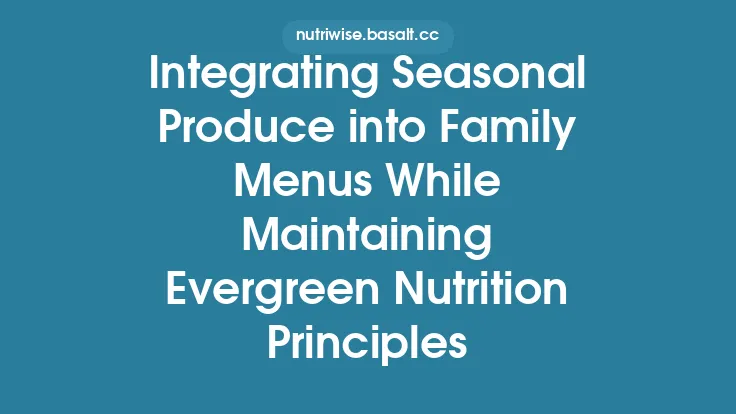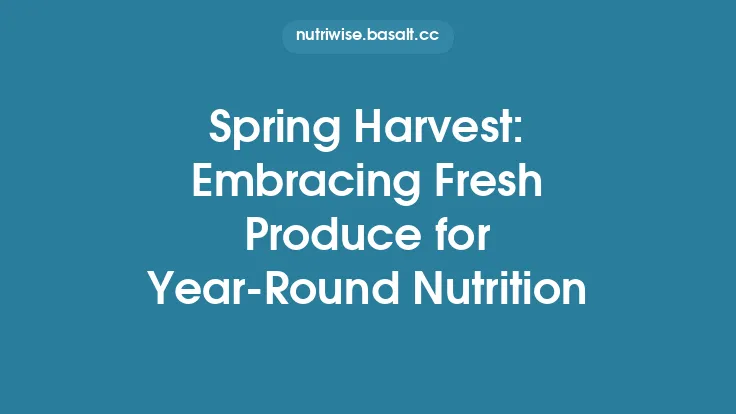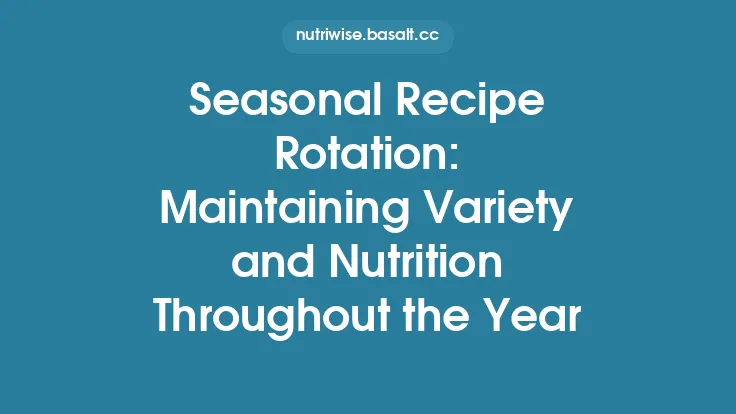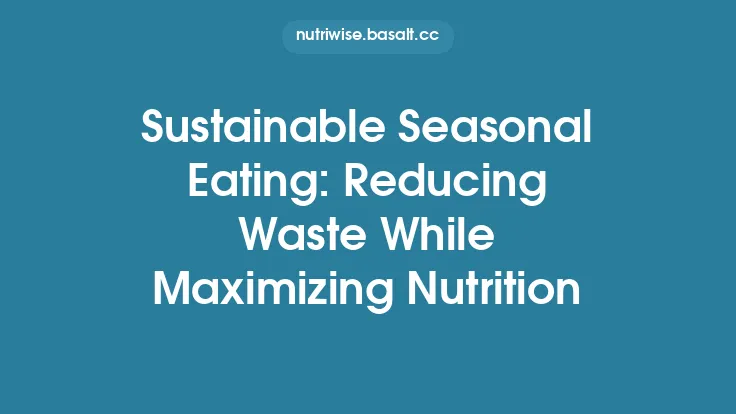Seasonal changes shape the foods that are most abundant, affordable, and flavorful at any given time of year. While the calendar turns, the body’s micronutrient demands remain constant, yet the supply of vitamins and minerals can fluctuate dramatically with the harvest. Understanding how to align eating patterns with the natural rhythm of the seasons is a powerful way to safeguard against hidden deficiencies without relying on constant symptom monitoring or elaborate screening programs. This article explores the science of seasonal nutrition, practical ways to capture the full spectrum of micronutrients throughout the year, and evergreen strategies for preserving nutrient quality from farm to table.
The Seasonal Landscape of Micronutrient Availability
1. Fresh‑Produce Cycles and Their Nutrient Profiles
- Spring: Leafy greens (spinach, kale, Swiss chard) surge, delivering high levels of folate, vitamin K, and iron. Early‑season berries introduce vitamin C and anthocyanins.
- Summer: Sun‑rich fruits (peaches, apricots, mangoes) and vegetables (tomatoes, bell peppers, zucchini) peak in vitamin C, beta‑carotene (pro‑vitamin A), and potassium.
- Autumn: Root vegetables (sweet potatoes, carrots, beets) and squashes become abundant, offering beta‑carotene, magnesium, and zinc. Apples and pears provide soluble fiber and phytonutrients.
- Winter: Cruciferous vegetables (cabbage, Brussels sprouts, cauliflower) and hardy greens (collard, kale) retain vitamin C, calcium, and glucosinolates. Citrus fruits, stored from the previous season, supply vitamin C and flavonoids.
2. Climate‑Driven Variations in Micronutrient Synthesis
- Sunlight Exposure: UVB intensity directly influences cutaneous vitamin D synthesis. In higher latitudes, winter months can reduce endogenous production to <10 % of summer levels, necessitating dietary compensation.
- Temperature and Soil Moisture: Cooler soils often increase the concentration of certain antioxidants (e.g., anthocyanins in cold‑grown berries) while warm, well‑irrigated conditions can boost mineral uptake (e.g., potassium in summer melons).
3. Global Trade and “Out‑of‑Season” Produce
While imported produce can fill gaps, it may suffer nutrient loss during long transport and storage. Understanding the trade‑off between convenience and nutrient density helps prioritize truly seasonal options whenever possible.
Capturing the Full Micronutrient Spectrum Year‑Round
1. Diversify Within Each Season
Even within a single season, aim for a “rainbow” of colors. Different pigments correspond to distinct phytonutrients:
- Red/Orange: Lycopene, beta‑carotene (vitamin A precursors)
- Green: Chlorophyll, lutein, folate
- Purple/Blue: Anthocyanins, resveratrol
- White/Yellow: Flavonoids, potassium
A varied plate reduces the risk of missing any single micronutrient.
2. Leverage Preservation Techniques to Extend Seasonal Benefits
- Freezing: Rapid blanching followed by flash‑freezing preserves up to 90 % of vitamin C and most B‑vitamins. Frozen berries, peas, and leafy greens are excellent winter staples.
- Canning: Acidic foods (tomatoes, peppers) retain vitamin C and lycopene when processed at low pH. Low‑sodium, BPA‑free cans are preferable.
- Drying & Dehydration: Sun‑drying or low‑heat dehydrators concentrate minerals (e.g., iron in dried apricots) while maintaining fiber.
- Fermentation: Sauerkraut, kimchi, and fermented vegetables boost vitamin K₂ and introduce beneficial microbes that enhance mineral absorption (e.g., calcium, magnesium).
3. Pair Foods to Maximize Bioavailability
- Vitamin C + Iron: Consuming citrus or bell peppers alongside iron‑rich plant foods (lentils, spinach) converts non‑heme iron to a more absorbable form.
- Fat‑Soluble Vitamins + Healthy Fats: Carotenoids (beta‑carotene, lutein) are better absorbed with dietary fats—add a drizzle of olive oil to roasted carrots or a handful of nuts to a kale salad.
- Calcium + Vitamin D: Pair fortified dairy or fortified plant milks with sunlight exposure or modest supplementation during low‑UV months to support calcium uptake.
4. Seasonal Meal Planning Templates
| Season | Core Food Groups | Sample Micronutrient Focus |
|---|---|---|
| Spring | Leafy greens, peas, early berries | Folate, iron, vitamin C |
| Summer | Tomatoes, bell peppers, stone fruits | Vitamin C, beta‑carotene, potassium |
| Autumn | Squash, apples, root veg | Vitamin A, magnesium, zinc |
| Winter | Cruciferous veg, citrus, fortified grains | Vitamin D (via fortified foods), calcium, vitamin K |
By rotating these templates, you create a natural “nutrient calendar” that minimizes gaps.
Nutrient Stability: How Cooking and Storage Influence Micronutrient Retention
1. Heat Sensitivity
- Vitamin C & B‑vitamins: Highly water‑soluble and heat‑labile; short, low‑temperature cooking (steaming 3–5 min) preserves >80 % of content.
- Vitamin A (beta‑carotene): More stable under heat; gentle roasting can even increase bioavailability by breaking down cell walls.
2. Water Leaching
Boiling leafy greens can cause up to 50 % loss of water‑soluble vitamins. Opt for steaming, microwaving, or sautéing with minimal liquid.
3. Oxidation
Cut surfaces expose phytonutrients to oxygen. Store pre‑cut produce in airtight containers with a splash of lemon juice (ascorbic acid) to slow degradation.
4. Light Exposure
Photosensitive nutrients (riboflavin, chlorophyll) degrade under prolonged light. Keep opaque containers for storage, especially for powdered supplements.
Seasonal Adjustments for Specific Micronutrient Challenges
1. Vitamin D in Low‑Sunlight Months
- Dietary Sources: Fatty fish (salmon, mackerel), fortified dairy/plant milks, egg yolks.
- Strategic Supplementation: A modest daily dose (800–1,000 IU) during winter can maintain serum 25‑OH‑vitamin D within optimal ranges for most adults.
2. Iron During Plant‑Heavy Seasons
- Spring & Summer: Emphasize iron‑rich legumes and greens, paired with vitamin C‑rich fruits.
- Cooking Tip: Use cast‑iron cookware; a 10‑minute simmer can add 2–5 mg of iron to the dish.
3. Magnesium in Autumn & Winter
- Sources: Nuts (almonds, cashews), seeds (pumpkin, chia), whole grains, dark chocolate.
- Seasonal Pairing: Add a tablespoon of pumpkin seeds to roasted winter squash for a magnesium boost.
4. Zinc When Fresh Seafood Is Scarce
- Plant Sources: Legumes, whole grains, nuts.
- Enhancement: Soak and sprout beans to reduce phytate content, which otherwise binds zinc and impairs absorption.
Building a Resilient Seasonal Pantry
1. Stock the Essentials
- Frozen Mixed Vegetables: A blend of broccoli, peas, and carrots provides a baseline of vitamin C, folate, and beta‑carotene.
- Canned Tomatoes & Tomato Paste: Rich in lycopene; use as a base for soups and stews.
- Dried Legumes & Whole Grains: Lentils, chickpeas, quinoa, and brown rice supply iron, zinc, and B‑vitamins.
- Nuts & Seeds: Almonds, walnuts, sunflower seeds, and flaxseed deliver vitamin E, magnesium, and omega‑3 fatty acids.
2. Rotate Stock Regularly
Adopt a “first‑in, first‑out” system to ensure older items are used before newer ones, minimizing nutrient loss from prolonged storage.
3. Seasonal Bulk Purchases
When a particular fruit or vegetable is at peak abundance (e.g., summer tomatoes), buy in bulk and process (freeze, can, dry) for off‑season use. This reduces cost and preserves nutrient density.
Monitoring Micronutrient Intake Without Clinical Tests
1. Food‑Frequency Journals
Track weekly servings of each food group. Aim for at least five servings of colorful vegetables and two servings of fruit per day. Use a simple spreadsheet to flag any missing color categories.
2. Simple Nutrient Checklists
Create a seasonal checklist that includes:
- Vitamin C: Citrus, berries, peppers
- Vitamin A: Carrots, sweet potatoes, leafy greens
- Vitamin D: Fortified foods, fatty fish, supplement (winter)
- Iron: Legumes, dark greens, fortified cereals
- Calcium: Dairy/fortified alternatives, cruciferous veg, nuts
Mark each item as “present” or “absent” for the day; aim for >80 % coverage over a week.
3. Visual Cues
A well‑balanced plate should display at least three distinct colors. If the plate looks monochrome, it likely lacks a range of micronutrients.
Adapting Seasonal Nutrition to Different Living Environments
1. Urban Dwellers with Limited Garden Space
- Container Gardening: Grow herbs, lettuce, and cherry tomatoes on balconies.
- Community Gardens: Participate in local plots to access fresh, seasonal produce.
2. Rural Residents with Seasonal Harvests
- Preservation Workshops: Learn canning, fermenting, and root cellaring to extend the harvest.
- Co‑ops: Share surplus produce with neighbors to diversify micronutrient intake.
3. Remote or Food‑Insecure Settings
- Shelf‑Stable Micronutrient Packs: Stock fortified flours, powdered milk, and multivitamin powders that can be reconstituted as needed.
- Seasonal Food Aid Programs: Align distribution schedules with local harvest calendars to maximize fresh produce availability.
The Role of Lifestyle Synergy in Seasonal Micronutrient Balance
While the focus here is on nutrition, certain lifestyle habits naturally complement seasonal eating patterns:
- Outdoor Activity: In summer, increased sweating can raise the need for electrolytes (magnesium, potassium). Incorporate electrolyte‑rich foods (coconut water, bananas) post‑exercise.
- Sleep & Hormonal Rhythms: Shorter daylight in winter can affect appetite regulation; prioritize warm, nutrient‑dense meals (soups with legumes and leafy greens) to support satiety.
- Hydration: Cold weather can blunt thirst signals, risking reduced water intake and impaired nutrient transport. Aim for consistent fluid consumption year‑round.
A Year‑Long Micronutrient Blueprint (Sample)
| Month | Core Seasonal Foods | Key Micronutrients Targeted |
|---|---|---|
| January | Kale, Brussels sprouts, citrus, fortified oatmeal | Vitamin C, K, D, calcium |
| February | Swiss chard, oranges, canned beans | Folate, iron, vitamin C |
| March | Spinach, peas, strawberries (early) | Folate, vitamin C, iron |
| April | Asparagus, radishes, rhubarb | Vitamin K, folate, calcium |
| May | Rhubarb, early cherries, lettuce | Vitamin C, potassium |
| June | Tomatoes, bell peppers, berries | Vitamin C, lycopene, beta‑carotene |
| July | Zucchini, corn, peaches | Vitamin A, potassium |
| August | Eggplant, melons, apricots | Vitamin C, beta‑carotene |
| September | Apples, pumpkins, carrots | Vitamin A, potassium, fiber |
| October | Sweet potatoes, beets, pears | Vitamin A, magnesium |
| November | Brussels sprouts, cranberries, quinoa | Vitamin C, iron, zinc |
| December | Cabbage, citrus, fortified soups | Vitamin C, D, calcium |
By following this rotating framework, you naturally ingest a broad spectrum of micronutrients without the need for constant symptom tracking or clinical testing.
Closing Thoughts
Seasonal nutrition is more than a culinary trend; it is a scientifically grounded strategy that aligns the body’s steady micronutrient needs with the ebb and flow of nature’s bounty. By understanding which vitamins and minerals are most plentiful in each season, employing preservation methods that lock in nutrient value, and pairing foods to enhance absorption, you can construct a resilient, year‑round diet that minimizes the risk of hidden deficiencies. The approach is evergreen—no matter how climate patterns shift or food markets evolve, the principles of diversity, timing, and thoughtful preparation remain steadfast tools for optimal micronutrient health.





